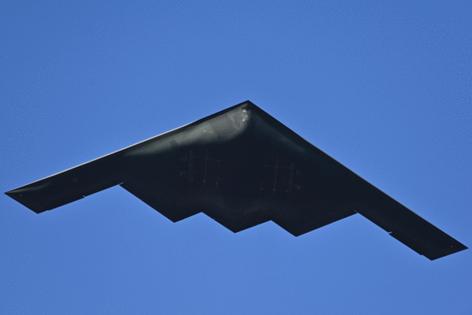Decoy stealth bombers and Tomahawk missiles: How the US Hit Iran
Published in News & Features
The heart of operation “Midnight Hammer” was a feint.
A group of American B-2 bombers — the only jets capable of deploying 30,000-pound bunker-buster munitions with a shot at breaching the mountains shrouding Iran’s Fordow nuclear facility — flew west across the Pacific Ocean. When those planes were spotted on flight-tracker data, they were seen as being deployed as a way to strong-arm the Islamic Republic into negotiations.
But in reality, they were decoys meant to maintain tactical surprise, according to U.S. Defense Secretary Pete Hegseth. While those planes got all the attention, another group of stealth B-2s flew east — under the radar.
Those moves were part of a 37-hour operation that resulted in strikes at the Fordow, Isfahan and Natanz nuclear sites this weekend, plunging the U.S. directly into a conflict between Iran and Israel in the Middle East and raising fears over deeper violence to come in the region and beyond. The concerns are extending to markets as well, with traders predicting stocks will drop, oil prices will spike and the dollar will strengthen.
In the end, the Saturday night operation, which the U.S. said was necessary to prevent Iran from acquiring a nuclear bomb, was deemed a success by the Pentagon.
No U.S. service members were lost, and Iran didn’t fire at any of the U.S. military assets, according to the officials. Hegseth said members of Congress were only notified after the planes were out of danger, contradicting earlier reports that President Donald Trump had informed Republican congressional leadership beforehand.
Addressing the nation late Saturday, Trump said Iran’s “key nuclear enrichment facilities have been completely and totally obliterated.” But independent analysis has yet to verify that claim, and the strikes may have created a new challenge to work out what’s left and where of the Islamic Republic’s atomic facilities.
The extensive U.S. operation included 125 aircraft overall, strikes by Tomahawk missiles launched from a submarine, and the use of 14 Massive Ordnance Penetrator bombs — the first time such bunker busters were used in combat.
There were few hints that the mission was set to be carried out this weekend. The White House had promised on Thursday that Trump would make a decision on a strike “within two weeks,” suggesting there might be more time.
But the president — who often spends weekends away from Washington — landed in the capital from New Jersey for a meeting in the White House’s Situation Room on Saturday. He was joined there by key members of his administration, including Vice President JD Vance, Chief of Staff Susie Wiles, Secretary of State Marco Rubio and Hegseth.
Rubio signaled on Sunday that Trump didn’t give his final go-ahead for the bombing campaign until the very last minutes before it was carried out.
“There are multiple points along the way in which the President has decisions to make about ‘go’ or ‘no-go,’” he said in a Fox News interview Sunday morning. “And it really comes right up to 10 minutes before the bombs are actually dropped.”
The flights in the mission amounted to the second-longest in the B-2’s operational history, according to Hegseth and Air Force General Dan Caine, the chairman of the Joint Chiefs of Staff. The longest was a 40-hour round trip in October 2001 in the initial phase of the Afghanistan war.
U.S. officials said 75 precision-guided weapons were used. The battle damage would take time to assess but “all three sites sustained extremely severe damage and destruction,” according to Caine.
“It would not be a surprise to me if, after an assessment period, we went back in and re-struck some of these targets to make sure that we achieved the effect,” said Joseph Votel, a former commander of the U.S. Central Command and now a fellow at the Middle East Institute. “That actually is a normal part of our military targeting process, is to strike, assess, and then if necessary, strike again to achieve the results that we’re looking for.”
Prior to the B-2 strikes on Fordow, a submarine with the Carl Vinson Carrier Strike Group in the Arabian Sea fired 24 Tomahawk cruise missiles, according to Caine and a graphic released by the Pentagon.
Hegseth said earlier on Sunday that “our boys in those bombers are on their way home right now.” A U.S. official said a woman was among those who piloted the B-2s.
The Defense Secretary also said the mission was focused on destroying Iran’s nuclear program and not regime change in Tehran. “The mission was not, has not, been about regime change,” he said.
“This is a plan that took months and weeks of positioning and preparation, so that we could be ready when the president of the United States called,” Hegseth said. “It took a great deal of precision. It involved misdirection and the highest of operational security.”
But Rubio made clear that Iran needs to abandon its nuclear weapons ambitions.
“At the end of the day, if Iran is committed to becoming a nuclear weapons power, I do think it puts the regime at risk,” Rubio said Sunday on Fox News. “I really do. I think it would be the end of the regime if they tried to do that.”
While the damage assessments are still coming in, Vice President Vance said he’s confident the U.S. strikes on Iranian sites “have substantially delayed their development of a nuclear weapon — and that was the goal of this attack.”
Iran’s nuclear program has been pushed back “by a very long time,” he said in an interview with NBC’s "Meet the Press." “I think that it’s going to be many, many years before the Iranians are able to develop a nuclear weapon.”
_____
(With assistance from Eric Martin, María Paula Mijares Torres, Natalia Drozdiak, Akayla Gardner, Ramsey Al-Rikabi and Pierre Paulden.)
_____
©2025 Bloomberg L.P. Visit bloomberg.com. Distributed by Tribune Content Agency, LLC.







Comments